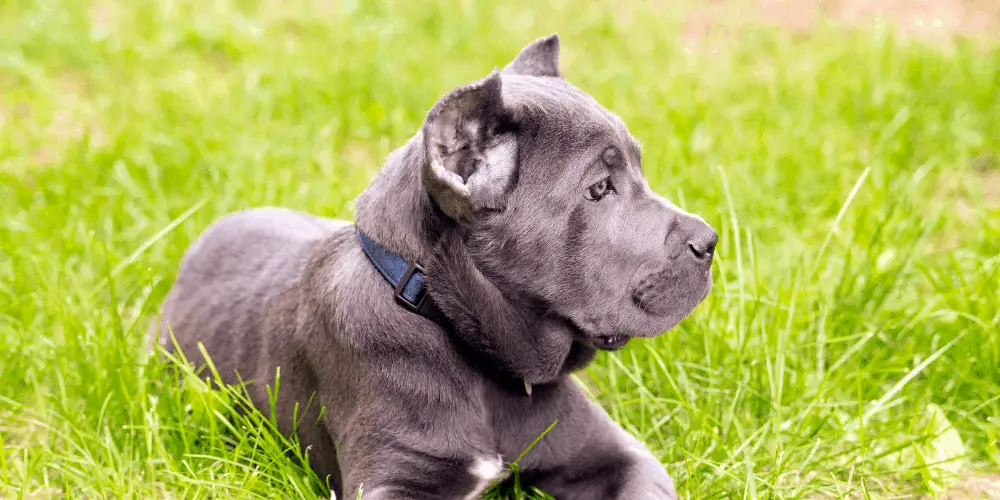Some dogs don’t do too well with uncropped ears, especially working breeds. Here, we’ll be talking about Cane Corso’s ear cropping- why it should be done, and the related styles, costs, and type of care a dog will need after going through this procedure.
Cane Corso’s ear cropping hasn’t always been something owners felt necessary. They had naturally upright ears for a long time, but eventually, through breeding with other breeds, they developed a floppier type of ear. The practice of ear cropping began in the late 1600s, but it is unclear when it began with this Italian dog breed.
The focus of this article will talk about several aspects of ear-cropping Cane Corso pups. Among which will be why to do it, how much it typically costs, what styles are available and what to do to take care of freshly cropped ears.
Why is Cane Corso Ear Cropping Done?
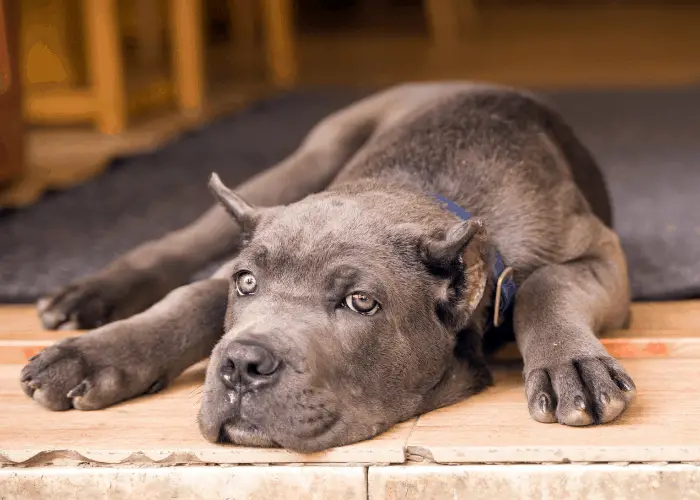
In today’s society, ear cropping is losing favor with dog lovers and overall animal lovers. Some countries worldwide have gone so far as to ban the practice of animal cruelty.
The cruelty argument quickly dissipates with modern practices, standards, medications, and hardcore facts. Even today, there are many reasons why ear cropping is still in demand that keep the practice alive.
1. Removing Altered Features
Some would argue that cropping the ears of a Cane Corso brings the ear back to its original form, supporting the health and long-term comfort of the breed.
2. Safety of the Working Dog
The best reasons point to the dog’s safety while performing job-like tasks like guarding or other security positions. Cane Corsos are a traditional “guard dog” with Roman Warrior Dog ancestry.
A lot can happen to a dog with floppy ears at the workplace, whether guarding someone’s home or out on the range protecting livestock from predators.
3. Removing Disadvantages
Floppy ears can bleed profusely and blind a dog in combat with another animal, giving it a huge disadvantage and could cost the dog its life against a predator. Against human intruders, the floppy ears of a Cane Corso or other breeds can be used as handlebars (so to speak).
Intruders that encounter a Cane Corso have a greater chance of overtaking the dog if it remains to have floppy ears. The ears can be grabbed and used to be physically manipulated, creating a dangerous situation for the dog.
There are other reasons to have their ears cropped that don’t rely on these jobs. Most of which contain possibilities of getting their ears stuck or caught on something, placing the dog at risk of long-term injury, scarring, or even death.
4. Advantages at Dog Shows
This is probably the most presumptuous and superficial reason a Cane Corso would have its ears cropped, but it is relevant. The standard head shape of the breed is better on display with cropped ears.
According to the standards of various groups, the head should be more square-like rather than rounded. When the ears aren’t cropped, the head appears to have a more rounded shape than it would with cropped ears.
Sum Up
So, though it appears cruel on the surface, it’s a necessary step that a working dog of this nature must go through. Today, some people are just looking for a pet rather than a worker, but love the strength and demeanor of a Cane Corso.
For this and several other reasons, we’ll talk about in other sections, getting a Cane Corso’s ears cropped is left up to a new pup owner rather than being up to the breeder.
At What Age Can You Crop a Cane Corso’s Ears?
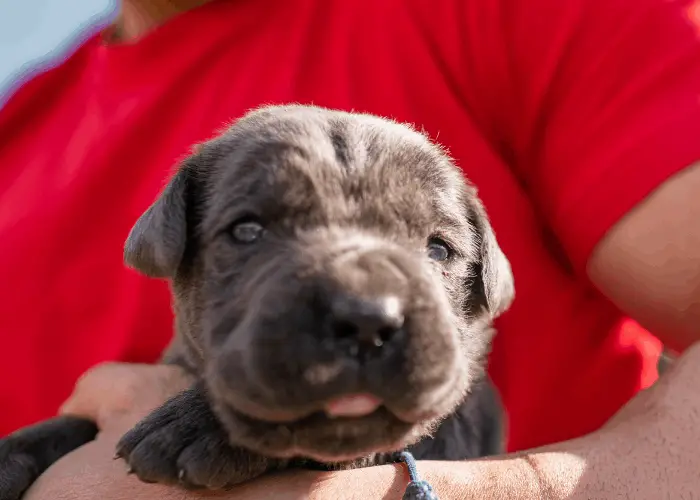
Unlike Cane Corso tail docking between 2-5 days old, ears are done much further in the puppy’s progress, most often around the 2-month-old mark or just a few weeks beyond that.
The common Cane Corse ear crop age is (as a rule of thumb) between 7-12 weeks (some vets recommend 8-12 weeks as well). This is the ideal timeframe for a few good reasons.
- After 12 weeks, the cartilage in the ear will tend to conform to the drooped shape and set (or harden) that way. Even after being cropped, the ear cannot sit completely upright.
- Puppies younger than 7 weeks are at greater risk of infections and would suffer a difficult time being bandaged, as they would still rely heavily on their mother (who would no doubt want to remove any bandaging or topical medications).
- The development of the ear is in a sweet spot between 7 (or 8) weeks and 12 weeks, as its shape and proportions are clearly defined yet not set in stone (cartilage hasn’t yet hardened into shape). The Veterinarian needs to make more of a guess as to how the ear might develop, risking the removal of either too much or too little of the ear.
Ear Cropping Styles
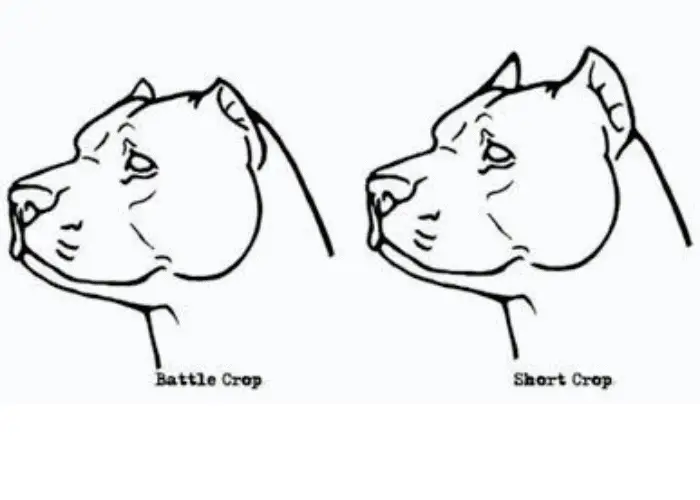
There are four most used styles of ear cropping:
- Battle Crop– The battle crop style is the one that removes the most amount of material, leaving nothing to grab back in the dogfighting days. This style leaves nearly nothing left of the ear but remains an option for some breeds.
- Short Crop– This crop is just a step above the battle crop because it’s slightly longer. When done properly, about two-thirds of the ear is left intact.
- Show Crop– The show crop leaves enough ear behind to allow the ear to have a more defined, triangular shape.
- Tall Crop– This is one of the longest available styles for certain breeds of dogs. This style often requires support to heal in an erect position atop of the head as it has more material than the other three.
Which Crop is Common for Cane Corso?

It isn’t abnormal to find any of the four above options upon the head of a Cane Corso. But of the four, the show crop provides this breed’s desired triangle shape.
Note: For dogs that are for show, clubs like the AKC allow entries for cropped and un-cropped variations of the Cane Corso but specify that the crop must be an equilateral triangle. (crop styles: image source)
Cost
Unfortunately, you’ll have to do some homework regarding Cane Corso’s ear crop costs. If it’s not too late, the best time to figure this into the equation is before buying a pup.
Cropping pricing is difficult to pin down, ranging between $150.00 to over $800.00. It will be different from Vet to Vet.
When researching, it’s important to ensure that every aspect of proper care is involved in the price (including aftercare). Doing so will avoid any surprise charges and help you to get a more concrete price.
Cane Corso Ear Cropping Healing Time

On average, the healing time can last between 7-14 days. At about this time, the pup needs to return to have its stitches removed.
The anesthetic will completely wear off within a few hours after the initial surgery. The Cane Corso pup will likely be alert and want little more than to go home and eat.
The following day the puppy will behave as if nothing ever happened and will desire to proceed through its normal daily routine. Despite its desires, owners will have to give attention to the pup’s ears, limiting any roughhousing as much as possible (particularly with fellow pups or other pets) while keeping an eye on the stitched areas.
Cane Corso Ear Cropping Aftercare
Cane Corso ear cropping aftercare involves applying topical disinfectant on the stitched areas twice a day.
If a rack (cone collar for puppies) keeps the pup from kicking or scratching its ears, it must be positioned to not irritate the ears.
Cane Corso With Ears vs Cropped Ears
As previously mentioned, breeders have left the decision in the hands of the new owner of a Cane Corso pup.
This weighty decision handed off to owners helps expand the breeder’s customer base, allowing the pups to be sold at an age-appropriate time.
Naturalists and activists have been battling it out for decades about the Cane Corso with ears vs cropped, what’s cruel or what isn’t, and what’s right or wrong.
We’re going to ignore all of the arguments and just go with the choices of an individual owner.
1. Cane Corso With Ears

Those who are against the practice don’t have to support it by purchasing a pup with cropped ears and can allow the dog to keep its extra flaps. The ears will be folded over forward, draping on either side of the dog’s head- much in the way you’d expect from a Labrador Retriever.
The cuteness factor of a pup or even an adult is preserved with the folded-over ear look. This alone may sway an owner to keep the ears un-cropped.
Also, folks that get a Cane Corso pup may not intend to utilize the dog for any of its natural strengths. An owner may not want it to guard or perform any other job where it willingly throws itself between owners or property and any form of danger.
2. Cane Corso with Cropped Ears

The cropped ear appearance is generally the norm for this breed. More often than not, when you see a picture of a Cane Corso or one walking with its owner, its ears will be cropped.
The practical reasoning for cropping the ears of a Cane Corso have been previously touched upon, but other reasons involve the general menacing appearance of the breed with its pointed ears. Some people, whether they want to use the dog as a guard dog or not, love the rough and tumble look of the cropped-eared Cane Corso.
Cane Corso Ear Cropping Near Me
Be diligent and cautious when looking for someone qualified to do any operative actions on your dog, regardless of simplicity. Many methods are available to find someone qualified to perform the cropping procedure.
The internet will be your most powerful tool to find someone reputable and reasonably accessible. You’ll likely settle on someone who ticks these boxes when pricing out the procedure- but cost shouldn’t trump reputation and competency in this decision.
With a search, you’ll be able to check out Vets in your area you could contact or look into. Also, there are sites provided by Cane Corso enthusiasts or clubs that will have a list of veterinarians specializing in this type of surgery.
Final Thoughts
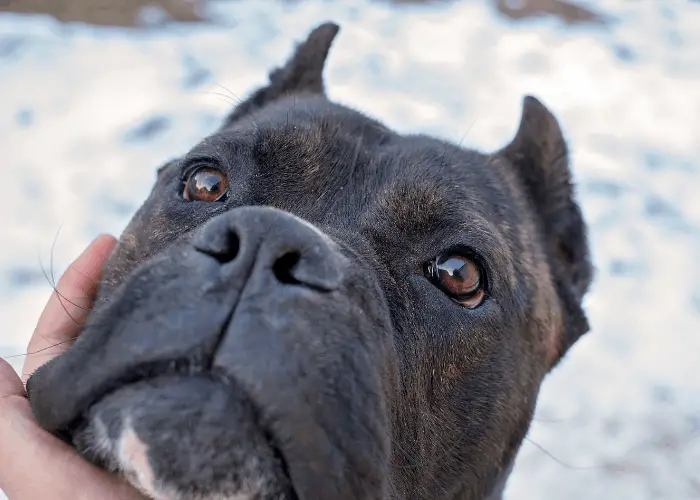
In any good argument, there are valid points to both sides, and whether or not you should get your Cane Corso pup’s ears docked is one of these arguments. Fortunately, most people have the luxury of making this decision themselves.
If you’re interested in a Cane Corso pup, you can be armed foreknowing that you’ll have to make this decision, knowing how to proceed after receiving your new four-legged friend.

